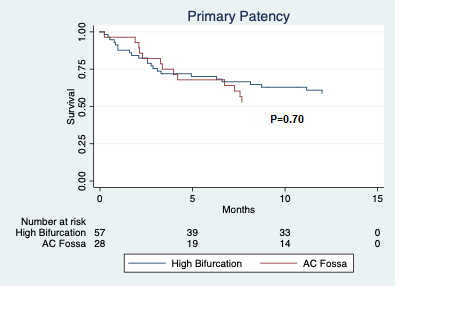Outcomes For Antecubital Arteriovenous Fistulas In Patients With High Brachial Artery Bifurcation
John Futchko, MD, John Denesopolis, MD, Patricia Yau, MD, Caroline Dong, MD, Evan Lipsitz, MD, Larry Scher.
Montefiore Medical Center, New York, NY, USA.
OBJECTIVES:
Pre-operative ultrasound vessel mapping is a crucial step in operative planning for permanent hemodialysis access creation. While the majority of the focus remains on vein caliber, anatomic arterial variants are often overlooked. Despite being a relatively common variation, little is known about the impact of a high brachial bifurcation on hemodialysis access outcomes. Our goal was to examine the relationship between a high brachial bifurcation (HB) and arteriovenous fistula (AVF) maturation and patency in patients undergoing upper arm hemodialysis access placement.
METHODS:
This was a retrospective review of antecubital fossa (ACF) arteriovenous fistulas created at our institution between January 1, 2009 and December 31, 2018. Patients with high brachial bifurcations were identified based on pre-operative vessel mapping. To allow for like comparison, AVFs performed with normal arterial anatomy contralateral to a high bifurcation were analyzed. Primary outcomes were functional patency and primary patency. Patients were followed for at least one year post-operatively.
RESULTS:
In total, 85 antecubital AVFs were analyzed; 57 ipsilateral to the high bifurcation, and 28 with normal anatomy contralateral to the high bifurcation. There was no significant difference between the two groups in rates of fistulas cannulated (61% HB vs. 68% control, p=0.64), or in rates of symptomatic steal (5% HB vs. 4% control, p=1.00) or in interventions required to achieve primary patency (23% HB vs. 21% control, p=1.00). The one-year functional patency rate was 49% in the HB group and 57% in the control group (log-rank test, p=0.56). The one-year primary patency was 60% in the HB group and 54% in the control group (log-rank test, p=0.70, Figure).
CONCLUSIONS:
High brachial bifurcations are a not uncommon variant encountered in pre-operative hemodialysis access planning. There was no significant difference in rates of primary patency, steal, or cannulation between antecubital AVFs performed in the high bifurcation and control groups. This study suggests that the presence of a high brachial bifurcation should not preclude AVF attempt in an extremity. 
Back to 2021 Abstracts
